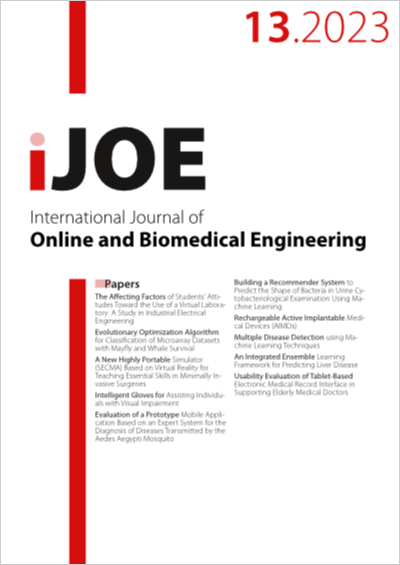Multiple Disease Detection using Machine Learning Techniques
DOI:
https://doi.org/10.3991/ijoe.v19i13.40523Keywords:
CNN, KNN, KNN classifier, VGG-16, MobileNet, InceptionNet, Alex Net, TinyMLAbstract
The COVID-19 disease outbreak resulted in a worldwide pandemic. Currently, the reverse transcription-polymerase chain reaction (RT-PCR), which relies on nasopharyngeal swabs to examine the existence of the ribonucleic acid (RNA) of SARS-CoV-27, is still a popular approach to testing for the disease. Despite the high level of specificity of testing with RT-PCR, the sensitivity of the method could be relatively low, and there is significant variability in efficacy depending on different sampling methods and the time of occurrence of symptoms. It is therefore essential for us to develop a machine-learning algorithm that can analyze computerized tomography images to detect the presence of COVID-19. Besides COVID-19, lung computerized tomography (CT) scan images can detect many other diseases, such as lung cancer, pneumonia, etc. This paper deals with the implementation of an algorithm that takes lung CT scans and lung X-ray images as input and predicts a list of probable diseases and possible diagnoses that infect the lungs. Machine learning algorithms will be able to predict disease by scanning the tiniest of regions easily missed by the human eye. This paper presents a survey of various machine learning algorithms that aid in detecting multiple diseases in lung CT scan images. Apart from the study of standard algorithms best suited for COVID-19 detection, this paper also includes recent trends. One of the major recent trends that can be incorporated into COVID-19 detection is TinyML. Tiny ML is an emerging area in machine learning algorithms that can be used to detect multiple diseases in lung CT scan images with better accuracy and in less time. This tool can aid doctors in their diagnosis and treatment of patients and help increase the efficiency of the treatment process. While understanding the features and mapping them using a hidden layer, there is a probability of compressing the dataset, as well as the model to process and classify the low-bit images in real-time using TinyML.
Downloads
Published
How to Cite
Issue
Section
License
Copyright (c) 2023 DIPANJAN ACHARYA, EASHWER K, SOUMYAKUMAR, SIVAKUMAR R, KISHORERAJA PC, RAMASAMY SRINIVASAGAN

This work is licensed under a Creative Commons Attribution 4.0 International License.


